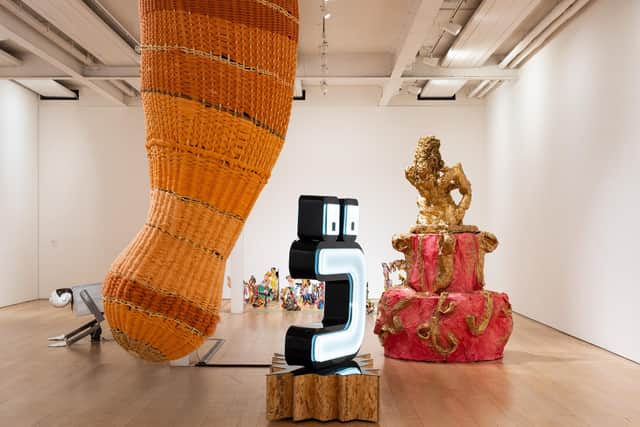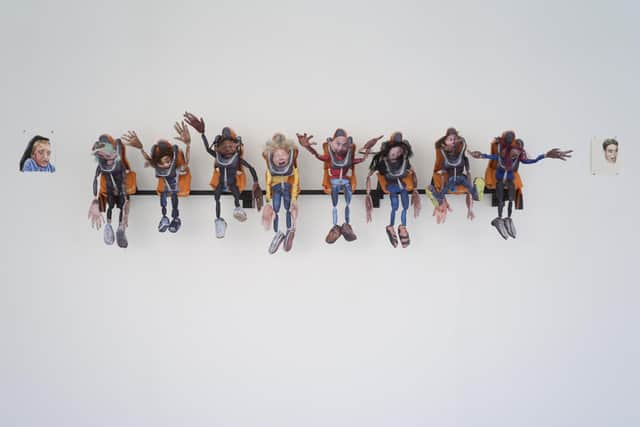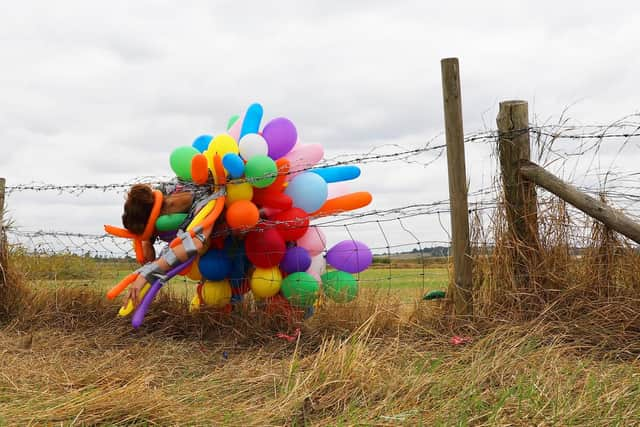Art reviews: Poor Things | Janise Yntema | David Michie
Poor Things, Fruitmarket Gallery, Edinburgh ****
Janise Yntema: Where Sky Meets Earth, Scottish Gallery, Edinburgh ****
David Michie: The Early Years, Scottish Gallery, Edinburgh ****


Advertisement
Hide AdIf William Morris wallpapers and fabrics are now the hallmark of a comfortable bourgeois existence, that was not at all the original idea. Morris and his friends had set out to improve the quality of life for all by making well designed furniture and furnishings cheaply enough to be widely accessible. Although this didn’t actually work – production costs were far too high – the idea was infectious, and in Germany the designers of the Bauhaus followed Morris’s lead. In Italy in the Sixties Arte Povere was an art movement in the same tradition. The artists sought consciously to break with the expensive art materials associated with wealth like oil paint, bronze and marble, and to use instead the ordinary, the humble and the thrown away.
Arte Povere was immensely influential and the title of the new show at the Fruitmarket, Poor Things, immediately recalls it. (The curators have said that they were unaware of the Alasdair Gray book of the same name.) The art in the show, too, recalls Arte Povere, much of it made from recycled this and that. Indeed the two artists, Emma Hart and Dean Kenning, who together initiated the show and selected the other 20 artists involved, talk about “the everyday thingness of sculpture… made of ordinary materials,” words that could easily have been spoken by one of the Italians 60 years ago.
More than that, however, with a distant echo of Morris & co, the two artists also describe their intention to explore themes of art and social class. The gallery guide, for instance, is prefaced with the question, “How does class operate in the art world today?” Elsewhere the organisers express “the hope that together the sculptures might reveal the multiplicity of experiences of artists whose work speaks to working and lower-middle class backgrounds.” Nevertheless, the results are not exactly a social-realist call to arms in a new class war. Whatever the motive, the work mostly reflects the universal, mildly iconoclastic aesthetic of the modern art school. Wealth is perhaps really more of an issue with art now than the old idea of class. Just consider the crushing effect of fees on any notion of universal access to higher education in England, for instance, and that of course includes art.
That said, the work here is certainly lively. As you enter you pass under What You Make of It (Trace) by Simeon Barclay. It’s a zinc bath suspended on pulleys and done up as a hanging bath-tub boat with oars. The artist’s father came from the Caribbean in the fifties. The gallery guide poses a question to each piece and here it inquires of the artist, “How does your suspended bath present a narrative which addresses the dynamics of identity?” Art should be autonomous and not need the artist to speak for it, but given that information, this improbable vessel does seem a touching comment on immigration past and present.


Inside the gallery, you are greeted first by Jamie Cooper’s Nomnom, a large neon letter "C” with luminous bug eyes, and by Dean Kenning’s Renaissance Man, a metal box with legs and head that squeaks as its limbs move in a futile crawl to nowhere. It is a comment, the artist says, on repetitive manual labour. One of the most effective pieces here is Anne Ryan’s Friday on my Mind. It is a set of 15 or so small, standing figure groups made of cut-out paper and arranged on domestic vinyl flooring. The figures are not precisely drawn but clear enough to suggest people having a good time – on a Friday night perhaps. The question for this work is a real poser: how do joy and pleasure relate to class?
Whatever the answer to that question, there is not much pleasure in Rebecca Moss’s very uncomfortable video, Home Improvement. She films herself in her back-garden sitting in her dressing gown with coat hangers hooked into the corners of her mouth. Hanging buckets tied to the hangers fill steadily with water till the drag on her cheeks becomes unbearable. Pretty pointless discomfort, I reckon. In another film, dressed as Bob Dylan’s balloon-man, she tries to climb a barbed wire fence with the inevitable comical consequence.
Advertisement
Hide AdAmongst other things on the ground floor, a group of works from the Eighties by Eric Bainbridge does seem by its date to be slightly out of synch with the rest. They include a life-size dinosaur, but generally they look like furniture and are all upholstered in leopard skin print. The fabric is evidently the link, for the rhetorical question here is, “Is the fake animal fur print a marker of class?” You might ask in reply, “would the dinosaur care?” Also on the gourd floor is a group of standing figures made out of recycled bits and pieces by Linda Aloysius. They are delightful as somehow distinct and vivid personalities come through the unpromising materials. They have distinct personalities and in that they reminded me of Miró’s characteristic Personnages. These were made in the same way from rubbish. That might seem to develop out of of Art Povere, but in fact Miró and Picasso too both got there long before the Italians.
In the upper gallery Jospeh Buckley’s Crystal Landlord is a dominant piece. Enthroned with a transparent plastic face and snakes for feet, he is both sinister and topical in this age of rented living, rapacious landlords and spiralling rents. Even more imposing is Brian Griffiths’ The Body and Ground (Or Your Brittle Smile). A giant teddy bear’s face roughly made of canvas, it fills a whole corner of the gallery. Another delightful piece here is Rosie McGinn’s Oblivion. It is a row of little figures sitting on a bar. Oblivion is the name of a roller-coaster at Alton Towers and the little figures' clothes flutter in the wind from an electric fan as though they were actually riding on it. There is much more to admire here. If Poor Things doesn’t quite fulfil its wider, social ambitions – and, perhaps, mounted on the wall four loudspeakers made by Emma Hart out of painted stoneware and evidently dumb, make a silent comment on that – it is lively show.


Advertisement
Hide AdElsewhere the modes of art rejected here prove themselves still valid. At the Scottish Gallery, Janise Yntema celebrates the beauty of landscape and atmosphere in a series of paintings of mountains beneath cloudy skies and misty islands seen over wide stretches of sea. In a couple of paintings she even seems to have taken her viewpoint from the air. Her pictures, large and small, though all of them landscapes or seascapes, are never in landscape format. They are either square or are upright rectangles and are thus perhaps images of aspiration beyond the merely earthbound.
Also at the Scottish Gallery, in a nice conjunction of mother and son, David Michie’s work is shown alongside Anne Redpath’s. There is however also an intriguing group of Michie’s early works. Among them, a painting of factories reflects how, like John Houston and others at the time, Michie was much influenced by the social realism he found in contemporary Italian cinema, in films like Vittorio de Sica’s Bicycle Thieves for instance. Thus we are taken back to the immediate Italian precursors of Art Povere and so come full circle.
Poor Things until 25 May; Janise Yntema and David Michie until 25 March